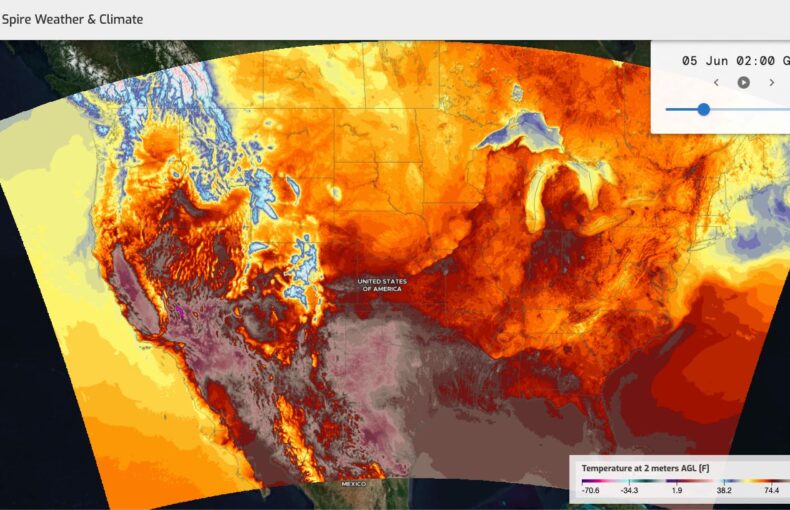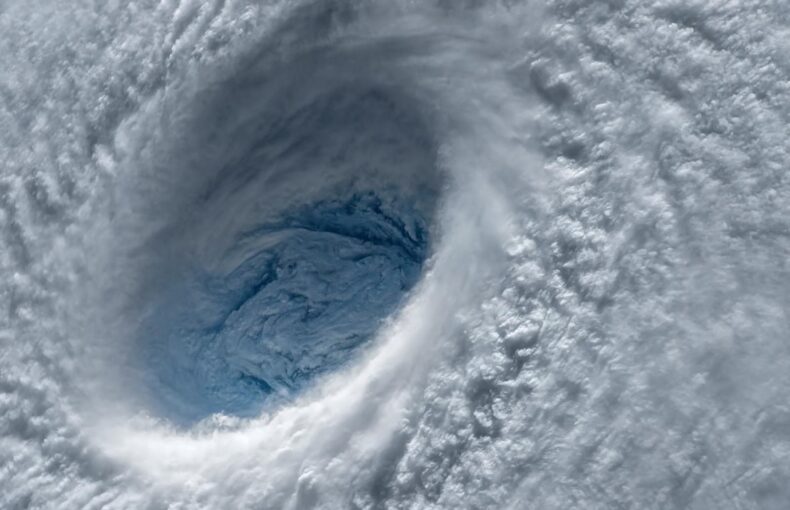Accessing weather data from the ‘cloud’: Accelerating innovation and improving collaboration
The world of weather is a highly chaotic yet also a highly collaborative space. At Spire, we highly value our strategic partnerships with world-leading organizations such as the National Oceanic and Atmospheric Administration.
Over the last five years, Spire’s team of data scientists, meteorologists, software engineers, remote analysts, and other essential members has diligently worked to advance our satellite technology and refine our exclusive numerical weather models, pushing the boundaries of innovation in the field of weather forecasting.
By building and deploying a constellation of 100+ Low-Earth Orbit satellites equipped with cutting-edge sensors, Spire captures precise atmospheric measurements and delivers high-quality weather data to enhance forecasting accuracy. With its innovative use of radio occultation, Spire Global has revolutionized the way weather information is gathered, offering invaluable insights that empower meteorologists and decision-makers worldwide.
In addition to its own data, Spire greatly values data from the National Oceanic and Atmospheric Administration (NOAA), accessing and leveraging the data to advance the weather forecasting industry and foster innovation. An aspect of this data access lies in Spire Global’s utilization of a subset of datasets hosted on the cloud through NOAA Open Data Dissemination (NODD) and accessed via Amazon Web Services (AWS). Such data include the near real-time NOAA Geostationary Operational Environmental Satellite Series (GOES-R), the High-Resolution Rapid Refresh (HRRR) model, and the Japan Meteorological Agency’s (JMA) Himawari Series.
By incorporating these high-quality, near real-time datasets into their weather prediction models Spire Global further enhances the accuracy and reliability of their forecasts. In this manner, Spire Global and NOAA provide industry, academia, and the public with critical environmental data that supports a more climate resilient world.
How Spire Global uses NOAA’s GOES-R and Himawari Datasets
NOAA’s GOES-R in combination with the JMA Himawari datasets serve as critical inputs for Spire’s Cloud Analysis (CA) product. The CA product generates three-dimensional microphysical fields, including cloud liquid, cloud ice, rain, snow, and water vapor data.
These fields are primarily used internally within Spire’s Cloud Ingestion (CI) package. The CI package, in turn, helps initialize the Spire Operational Forecast-Deterministic (SOF-D) model, which enables more accurate forecasts of clouds, precipitation, and other meteorological variables.
Spire’s Operational Forecast-Deterministic (SOF-D) is an advanced weather forecasting system developed by Spire Global. It is designed to provide accurate, and highly detailed weather forecasts for various regions across the globe. SOF-D utilizes a combination of cutting-edge numerical weather prediction models, innovative data assimilation techniques, and Spire’s extensive satellite observations to generate precise and reliable global weather predictions.
The system incorporates a range of data sources, including satellite observations, NOAA’s datasets, ground-based weather stations, and atmospheric models, to capture a comprehensive view of the atmosphere. Spire’s constellation of small satellites, equipped with instruments like radio occultation receivers and GPS receivers, plays a crucial role in collecting crucial atmospheric data that significantly enhances the accuracy of the forecasts.
Also, SOF-D employs advanced data assimilation algorithms to merge the collected observations with the underlying atmospheric models, allowing for the optimal representation of weather patterns and phenomena. This process results in advanced global weather forecasting capabilities, empowering various industries and sectors that rely on accurate weather information for decision-making.
Additionally, the SOF-D model, driven by the integrated NOAA data, offers medium-term forecasting capabilities of up to 15 days. This integration allows Spire to provide advanced weather solutions that meet the diverse needs of their customers.
Building customer-focused innovative weather data solutions
Furthermore, Spire Global uses the GOES-R and Himawari datasets, provided on NODD , to build its innovative Current Weather Conditions (CWC) product.
By integrating these datasets into Spire’s system, the company enriches the CWC product with near real-time and highly detailed information about atmospheric conditions. The GOES-R and Himawari datasets serve as essential sources of satellite imagery, offering high-resolution visual insights into cloud cover, precipitation patterns, and other key weather indicators.
Spire Global’s data processing algorithms merge this satellite imagery with other meteorological inputs to generate up-to-the-minute and accurate assessments of current weather conditions. This integration of NOAA’s datasets ensures that Spire Global’s CWC product provides meteorologists, weather enthusiasts, and various industries with a comprehensive snapshot of the prevailing weather conditions, enabling them to make informed decisions and take appropriate actions in response to changing atmospheric dynamics.
The Current Weather Conditions (CWC) products, which utilize the Cloud Analysis (CA) data, are generated on a high-resolution grid and are sent directly to customers via Spire’s Product Team API. These CWC products provide up-to-date information on current weather conditions, catering to short-term forecasting needs, including hourly and daily predictions.
Accessing weather data from the ‘cloud’: Accelerating innovation and improving collaboration
Spire Global’s ability to access NOAA’s weather datasets through a cloud-based platform represents a significant advancement in democratizing access to critical data and driving innovation within the weather industry.
NODD enables Spire Global to leverage the wealth of near real-time satellite observations and atmospheric models via the cloud, in a seamless and efficient manner.
By breaking down barriers to data access, NODD empowers researchers, scientists, startups, and other stakeholders to tap into this invaluable resource and unleash their creativity to develop new applications, models, and tools that further enhance weather forecasting and analysis.
NODD’s democratization of data and products not only fosters collaboration and knowledge-sharing but also sparks accelerated innovation. With increased access to NOAA’s datasets, researchers and developers can explore new avenues, test novel hypotheses, and fuel advancements in meteorology and climate science. Ultimately, partnerships drive the weather industry forward, leading to improved forecasts, enhanced preparedness for severe weather events, and a more resilient and sustainable future. Working with partners such as NOAA strengthens Spire’s mission to contribute to a brighter, better, and greener world.
Co-authors:
Jenny Dissen – NOAA Open Data Dissemination (NODD) Engagement Lead
Kate Szura – NOAA Open Data Dissemination (NODD) Communications Lead



